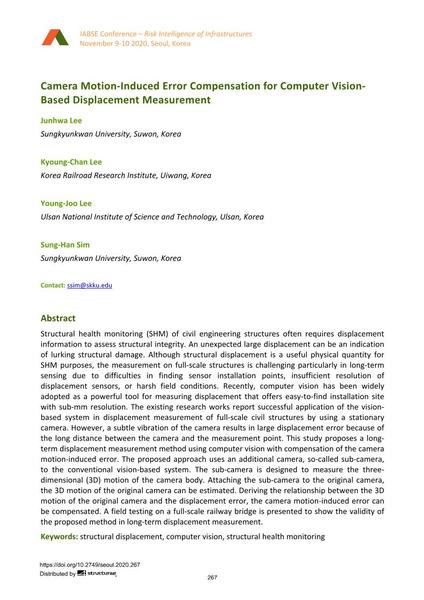Camera Motion-Induced Error Compensation for Computer Vision- Based Displacement Measurement

| Autor(en): |
Junhwa Lee
(Sungkyunkwan University, Suwon, Korea)
Kyoung-Chan Lee (Korea Railroad Research Institute, Uiwang, Korea) Young-Joo Lee (Ulsan National Institute of Science and Technology, Ulsan, Korea) Sung-Han Sim (Sungkyunkwan University, Suwon, Korea) |
|---|---|
| Medium: | Tagungsbeitrag |
| Sprache(n): | Englisch |
| Tagung: | IABSE Conference: Risk Intelligence of Infrastructures, Seoul, South Korea, 9-10 November 2020 |
| Veröffentlicht in: | IABSE Conference Seoul 2020 |
| Seite(n): | 267-268 |
| DOI: | 10.2749/seoul.2020.267 |
| Abstrakt: |
Structural health monitoring (SHM) of civil engineering structures often requires displacement information to assess structural integrity. An unexpected large displacement can be an indication of lurking structural damage. Although structural displacement is a useful physical quantity for SHM purposes, the measurement on full-scale structures is challenging particularly in long-term sensing due to difficulties in finding sensor installation points, insufficient resolution of displacement sensors, or harsh field conditions. Recently, computer vision has been widely adopted as a powerful tool for measuring displacement that offers easy-to-find installation site with sub-mm resolution. The existing research works report successful application of the vision- based system in displacement measurement of full-scale civil structures by using a stationary camera. However, a subtle vibration of the camera results in large displacement error because of the long distance between the camera and the measurement point. This study proposes a long- term displacement measurement method using computer vision with compensation of the camera motion-induced error. The proposed approach uses an additional camera, so-called sub-camera, to the conventional vision-based system. The sub-camera is designed to measure the three- dimensional (3D) motion of the camera body. Attaching the sub-camera to the original camera, the 3D motion of the original camera can be estimated. Deriving the relationship between the 3D motion of the original camera and the displacement error, the camera motion-induced error can be compensated. A field testing on a full-scale railway bridge is presented to show the validity of the proposed method in long-term displacement measurement. |
0.14 MB
- Über diese
Datenseite - Reference-ID
10563331 - Veröffentlicht am:
14.02.2021 - Geändert am:
21.05.2021



